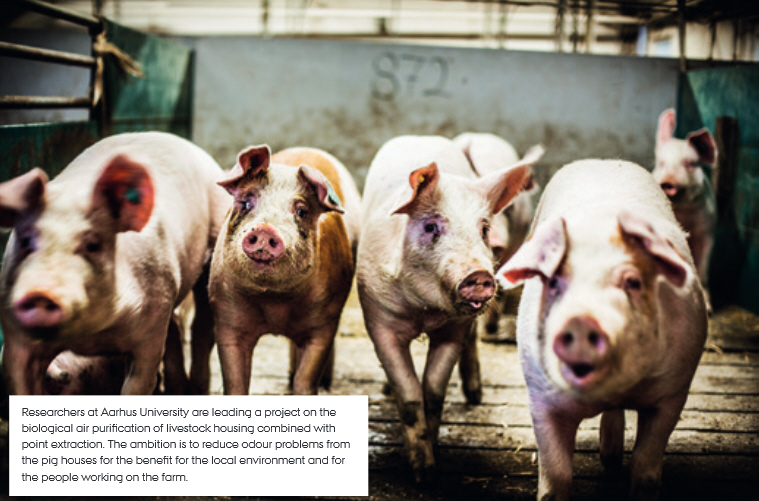



Danes Investigate How to Trap More Odour and Ammonia from Pig Farms
Researchers at Aarhus University are leading a project on the biological air purification of livestock housing combined with point extraction, with the aims to reduce odour problems from the pig houses for the benefit for the local environment and for the people working on the farm.Controlled extraction of air from slurry channels combined with an effective biological treatment is the bid of an ongoing research project for a reduction in odour from pig farms, according to the latest Annual Report from the Danish Centre for Agriculture and Food, DCA.
Better indoor air quality for the people working on the farm, a large reduction in emissions from livestock housing and the development of an effective biological air purification system with a large national and international market potential.
These are the great and promising ambitions of a new research project involving researchers from Aarhus University who will be working on the biological air purification of livestock housing combined with a relatively new ventilation principle called partial point extraction – the extraction of the air from the slurry channel under the pig house.
The combination of local exhaust ventilation and new knowledge on biological purification means that it could become possible to eliminate large amounts of ammonia and odours from the housing in an affordable way.
Project manager, Anders Feilberg from Aarhus University explained: "The continued development of livestock production in Denmark requires cost-effective solutions to reduce ammonia emissions and odours. Rather than trying to biologically purify the entire air volume from an animal house, an integrated solution consisting of biological air purification and point extraction has the potential to significantly reduce costs, achieve a more effective cleaning process and reduce waste volumes."
"This is because ammonia and odours are primarily emitted from the manure channel and can be captured in a ventilation flow that actually represents only 10 to 20 per cent of the total air volume."
The effect of combining the two known technologies is not precisely known but the people behind the project expect that there is a large potential and will be a great demand for such a product in the future, not least in light of the ever-tightening regulations on livestock production in a growing number of countries.
In the German state of North Rhine-Westphalia, all new pig finishing units with a capacity of more than 2,000 pigs will now need to have an air purification system installed. Over a three-year period, the requirement will be phased in for existing units with capacity in excess of 2,000 finishers.
The project partners also expect to be able to substantially reduce odour from the housing.
"The project will help to significantly reduce odour emissions so that the livestock industry can continue to develop without being a nuisance to its neighbours. We expect the air purification system will be able to reduce odour from the manure channel by more than 80 per cent," added Dr Feilberg.
It is expected that the combination of biological air purification and point extraction can reduce ammonia emissions by about 65 per cent. This number is achieved by an expected efficiency for the biological air purification unit of 90 per cent combined with the capture of 70 per cent of total ammonia emissions from point extraction.
The project also includes optimisation of the measurement and control of air flow from the point extraction to ensure an efficient capture of the polluting substances from the manure channel. The project will initially be laboratory-based where the basic processes in odour reduction will be examined, but with a concurrent installation of a full-scale demonstration unit at a pig facility.
Researchers from Aarhus University will be working alongside colleagues from the Pig Research Centre, Danish Technological Institute, a farmer and the manufacturer of industrial ventilation systems, SKOV A/S.

October 2014








